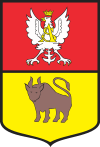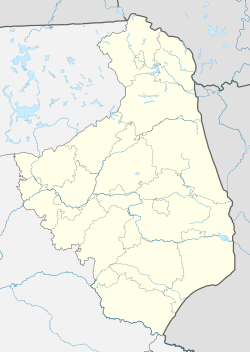Knyszyn
Knyszyn [ˈknɨʂɨn] (Lithuanian: Knišinas) is a town in north-eastern Poland, 26 kilometres (16 miles) northwest of Białystok. It is situated in the Podlaskie Voivodeship (since 1999), and was formerly in the Białystok Voivodeship (1975-1998). It is located within the historic region of Podlachia.
Knyszyn | |
|---|---|
.jpg) Saint John church in Knyszyn | |
 Coat of arms | |
 Knyszyn  Knyszyn | |
| Coordinates: 53°18′47″N 22°55′3″E | |
| Country | |
| Voivodeship | |
| County | Mońki |
| Gmina | Knyszyn |
| Town rights | 1568 |
| Area | |
| • Total | 3.68 km2 (1.42 sq mi) |
| Population (2006) | |
| • Total | 2,835 |
| • Density | 770/km2 (2,000/sq mi) |
| Time zone | UTC+1 (CET) |
| • Summer (DST) | UTC+2 (CEST) |
| Postal code | 19-120 |
| Area code(s) | +48 85 |
| Car plates | BMN |
History
In 1358 the territory became part of the Grand Duchy of Lithuania, soon afterwards in personal union with Poland.[1] It was the property of Court Marshal of Lithuania Michael Glinski until confiscated and passed to the Grand Chancellor of Lithuania Mikołaj Radziwiłł in 1507. In 1569 it was re-incorporated into the Crown of the Polish Kingdom.[1]
Royal residence of King Sigismund II Augustus
In 1568 Polish King Sigismund II Augustus granted Knyszyn town rights, and subsequently a town hall, public baths and a weigh house were built.[1] Knyszyn was the favorite residence of the King, and was the Polish court's main base for hunting expeditions into the nearby virgin forests. In the 1560s the king maintained a royal stud of over 3000 horses in Knyszyn, including large numbers of Arabian horses, among the first to be bred in northern Europe. Sigismund II died in the town in 1572, after which the royal property rapidly fell into neglect. Few signs of the former royal residence and extensive studs remain aside from foundations, which are poorly marked.
According to a legend, the heart of King Sigismund II is buried in the underground crypts of the church of St. John, which was built in the years 1579-1601 by the Great Crown Hetman Jan Zamoyski,[2] who became starost of Knyszyn in 1574.[1] A monument of the king is located at the Market Square[1] and the town's coat of arms contains the king's royal monogram.[3]
History since the 17th century
Knyszyn was a royal town of Poland. In 1630, Polish prince and soon-to-be King Władysław IV Vasa stayed in Knyszyn.[4] The town was devastated during the Polish–Swedish wars.[3] As a result of the Third Partition of Poland in 1795 it was annexed by Prussia; in 1807 it was annexed by Russia. At that time, many Jews settled in Knyszyn,[3] as a result of the discriminatory Russian regulations (Pale of Settlement), while the Polish population was subject to repressions and Russification policies.[1] Knyszyn became part of Poland again after the country has regained independence in 1918.[1]
During World War II it was occupied by the Soviet Union (1939-1941) and Nazi Germany (1941-1944). Knyszyn had a Jewish population of nearly 2000 until the Nazis invaded the area, after which most of Knyszyn's Jews were killed.[5]
Jewish history
The history of Jews in the town may date back as far as October 1605 when a Jew from Moscow sued the town over a beating he had endured. However, during the mid 1600s the town passed a law forbidding Jews to live in the town. Despite this decree a small Jewish community had settled in Knyszyn by 1679 and in 1705 a synagogue was built. In 1719 an agreement was reached between the Jewish community and the Church, requiring the former to pay a tax annually, with additional levees on several holidays. In exchange for this the exclusionary law was formally repealed.
By the early 1800s (1807) the Jewish population had reached 308. In 1810 an attempt was made to expel them but was quickly cancelled when the town economy collapsed. The Jews continued to benefit the Knyszyn economy by developing a textile industry during the 1830s. This helped support the burgeoning Jewish population which consisted of 1878 (out of a total town population of 3864) in the 1879 census.
Immigration lowered the population so that in the 1921 Polish census it was recorded as 1235. During the 1920s and 30s the community supported four restaurants, two groceries, and seven bakeries. They owned three mills, a leather factory, and a service station. There were also branches of the Betar organization and the Hadema sports club, and many charities. The 1939 population of 1450 had increased to 2000 by 1941. Most of this growth came from refugees who reached Knyszyn- then under Soviet occupation- from German-occupied regions.
The town was first occupied by the Germans for several weeks of September 1939 and then by the Russians until June 1941. Shortly after the Nazi occupation a pogrom occurred as well as the burning alive of 200 Jews in a synagogue. In November 1942 a massacre of the remaining Jewish population was carried out by the Gestapo. Fifty Jews survived by hiding in the nearby woods. Most immigrated to Israel after the war. The above is from https://kehilalinks.jewishgen.org/Knyszyn/occupation.html
Notable Residents
The town was the birthplace of Rabbi Shmuel Berenbaum (1920-2008), Rosh Yeshiva of the Mir Yeshiva in Brooklyn, New York.
Culinary History
Knyszyn is reportedly the birthplace of the Knish, a traditional Ashkenazic Jewish dish of flaky pastry filled with mushrooms, mashed potato, or other savory items.
References
- "Historia". Urząd Miejski w Knyszynie (in Polish). Retrieved August 15, 2019.
- "Historia Knyszyna". Urząd Miejski w Knyszynie (in Polish). Retrieved August 15, 2019.
- Słownik geograficzny Królestwa Polskiego i innych krajów słowiańskich, Tom IV, Warsaw, 1883, p. 200
- Tomasz Wisniewski. Jews in Knyszyn. Translated by Stephanie Ellis. Access date: 2011-07-21.
External links
| Wikimedia Commons has media related to Knyszyn. |